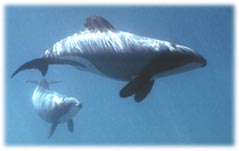 |
 |
|
|||
 |
|||
 |
|
| DOC Considering Marine Mammal Sanctuary for Porpoise Bay | |
| The Department of Conservation is considering creating a marine mammal sanctuary at Porpoise Bay (Curio Bay, Catlins). A small local population of some 48 Hector's dolphins live here and use the bay for feeding, breeding and social activities. The area is very popular with tourists who come to surf, fish and view Hector's dolphins in Porpoise Bay. Tourism has tremendous potential to educate the public about the behaviour and conservation problems of marine mammals. However, you can have too much of a good thing and it is important to ensure that the educational benefits outweigh any potential disturbance to the dolphins. More importantly, there is a risk of dolphins being entangled in gillnets which are occasionally used in the area. Recently, a commercial fisherman (who does not normally fish at Porpoise Bay) set a gillnet in the middle of the bay. He was asked to leave by local fishers, who have an informal code of practice of not using gillnets in Porpoise Bay. Another fisher trawled in the bay and dumped large amounts of dead fish that ended up on the beach at Porpoise Bay. The boundaries and regulations for the sanctuary are still being discussed. Among the possibilities discussed at a public meeting were restrictions on the times of day and parts of the bay where boat-based dolphin viewing would be allowed. Another option is to turn the fishing code of practice (banning the use of gillnets in the bay) into an enforceable regulation. This would protect the local dolphin population from entanglement in gillnets. The Trust's research is central in these decisions. Data on dolphin movements will help to define the boundaries of the sanctuary. Information on population size and breeding rate will help determine how much protection is needed from impacts like entanglement in fishing gear. Our studies of dolphin movements and behaviour will help determine the best times and places for boat-based viewing of the dolphins, and the best times and places to leave them alone. |
